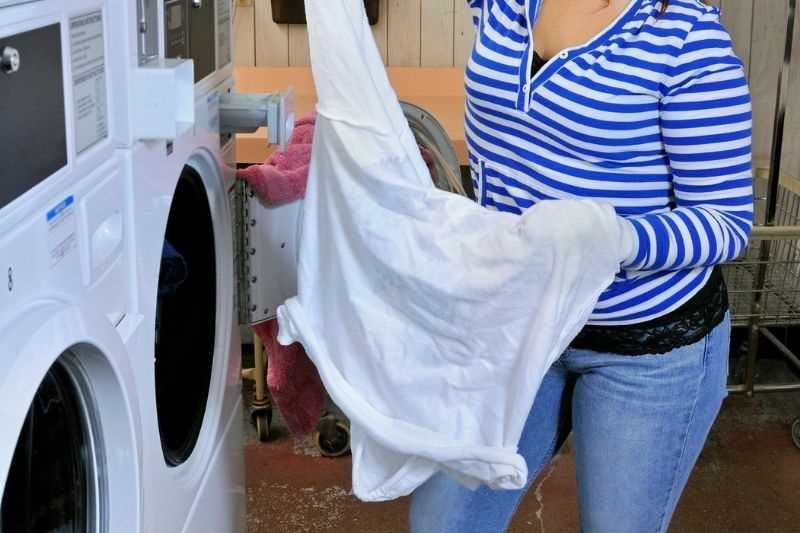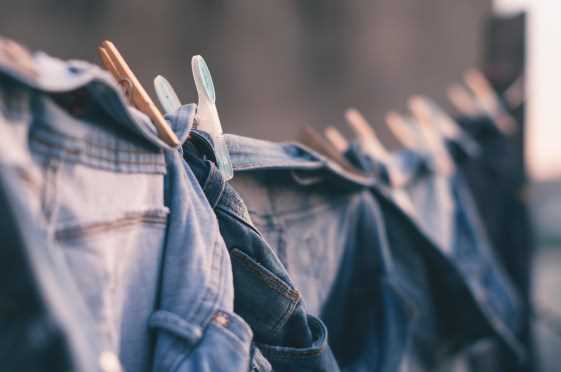




Drying your clothes properly is essential for maintaining their quality and longevity. One question that often comes up is whether you should dry your clothes inside out. This article aims to provide a guide to help you decide whether or not you should adopt this practice.
There are several reasons why you might consider drying your clothes inside out. One of the primary benefits is that it helps to protect the fabric from fading. When clothes are exposed to direct sunlight, the UV rays can cause colors to fade over time. By drying your clothes inside out, you can minimize this damage and help your garments retain their vibrant colors for longer.
Another reason to dry your clothes inside out is to prevent snags and pilling. When clothes rub against the surface of the dryer or other garments, they can develop snags or small balls of fibers known as pills. By turning your clothes inside out, you reduce the chances of this happening, keeping your clothes looking fresh and new.
However, it’s worth noting that not all clothes need to be dried inside out. Delicate fabrics like silk or lace may be better off air-drying or using a specialized drying rack to prevent any potential damage. It’s also important to check the care label on your clothes, as it may provide specific instructions on how to best dry them.
In conclusion, drying your clothes inside out can be a beneficial practice for preserving their quality and appearance. It helps protect against fading, snags, and pilling, ensuring your garments stay in excellent condition for longer. Just remember to consider the fabric type and check the care label for any specific instructions before drying.
By following these guidelines, you can make informed decisions about how to best care for your clothes and extend their lifespan. So, next time you’re doing laundry, take a moment to consider whether drying your clothes inside out is the right choice for you.
The Importance of Drying Clothes Inside Out
Drying clothes inside out is an important step in protecting your garments and ensuring their longevity. While it may seem like a small detail, it can make a significant difference in preserving the quality and appearance of your clothes in the long run.
Benefits of Drying Clothes Inside Out
- Prevents Fading: When clothes are exposed to direct sunlight while drying, the colors can fade over time. By drying your clothes inside out, you reduce the likelihood of fading and help them retain their vibrant colors for longer.
- Minimizes Pilling: Pilling is a common problem that occurs when small fibers on the surface of the fabric tangle together, creating tiny balls or pills. Drying clothes inside out reduces friction between the fabric and other garments, minimizing the risk of pilling.
- Avoids Snagging: Buttons, zippers, and other fastenings on clothes can potentially snag on other items in the dryer. By turning your clothes inside out before drying them, you reduce the chances of these fastenings catching on anything and causing damage to your garments.
- Preserves Embellishments: Many clothes come with delicate embellishments such as embroidery, beads, or sequins. Drying these garments inside out protects these embellishments from rubbing against other items or getting tangled in the dryer, helping to ensure they stay intact and in good condition.
Drying Tips
- Sort Your Laundry: Before drying your clothes inside out, make sure to sort your laundry by fabric type and color. This will help prevent any potential color bleeding and ensure even drying.
- Set the Appropriate Temperature: Different fabrics require different drying temperatures. Always check the care labels on your clothes to determine the appropriate temperature setting for your dryer.
- Use Dryer Balls: Adding dryer balls to the dryer can help improve airflow and distribute heat more evenly. This can reduce drying time and minimize wrinkles.
- Don’t Overload the Dryer: Overloading the dryer can prevent proper airflow, resulting in longer drying times and potentially wrinkled clothes. Make sure to leave enough space for your clothes to tumble freely.
- Remove Clothes Promptly: Once your clothes are dry, remove them from the dryer promptly. This will prevent wrinkles from setting in and help maintain the shape of your garments.
By making the simple habit of drying your clothes inside out, you can extend the life of your garments and keep them looking their best. It’s a small extra step that can make a big difference in preserving the quality and appearance of your clothes.
The Benefits of Drying Clothes Inside Out
Drying clothes inside out may seem like a simple task, but it has several benefits for both your garments and your laundry routine. Here are some reasons why you should consider drying your clothes inside out:
- Prevents Fading: Drying your clothes inside out can help prevent fading. When clothes are exposed to direct sunlight or heat, the fabric’s dyes can fade over time. By turning your clothes inside out, you can protect the outer surface of the fabric and minimize fading.
- Preserves Colors: In addition to preventing fading, drying clothes inside out can also preserve the vibrancy of their colors. By keeping the inner part of the fabric exposed to the drying elements, you can help maintain the original color of your clothes for longer.
- Reduces Pilling: Pilling, the formation of small balls of fuzz on the surface of fabric, is a common problem that occurs during the drying process. Drying clothes inside out can reduce friction between the garment’s surface and other items in the dryer, thereby minimizing pilling.
- Protects Prints and Embellishments: Many garments have prints, embroidery, or other embellishments on the outer side. Turning your clothes inside out can protect these delicate details from friction, heat, and other potential damages during the drying process.
- Improves Air Circulation: Drying clothes inside out can enhance air circulation around the fabric. This helps in the drying process by allowing air to reach areas that are usually covered when clothes are not turned inside out. Improved air circulation can also help reduce the time it takes for your clothes to dry.
- Prevents Snags and Tears: Zippers, buttons, and other fastenings on clothes can sometimes snag on other garments or the dryer’s interior during the drying process. By drying your clothes inside out, you can minimize the chances of snags and tears, thus prolonging the lifespan of your clothing.
Overall, drying clothes inside out is a simple yet effective way to protect your garments and ensure they retain their quality for longer. It helps prevent fading, preserves colors, reduces pilling, protects prints and embellishments, improves air circulation, and prevents snags and tears. Incorporating this practice into your laundry routine can make a significant difference in the longevity of your clothes.
How to Properly Dry Clothes Inside Out
Step 1: Prepare the Clothes
Before you begin drying your clothes inside out, make sure they are clean and fresh from the washing machine. Shake out any wrinkles and remove any lint or debris from the fabric. This will help to ensure that your clothes dry evenly and without any unwanted marks or stains.
Step 2: Turn the Clothes Inside Out
Once your clothes are prepared, turn each garment inside out. This will help to protect the outer surface of the fabric and prevent it from fading or becoming damaged by direct contact with the drying heat. Additionally, it will help to maintain the color and quality of your clothes for longer.
Step 3: Use a Gentle Drying Cycle
When drying your clothes, it’s important to use a gentle drying cycle to prevent any potential damage to the fabric. Select a delicate or low-heat setting on your dryer to ensure that your clothes dry slowly and properly, without any excessive heat that could cause shrinkage or fading.
Step 4: Separate Delicates

If you have any delicate garments, such as silk or lace, it’s best to air dry them separately from the rest of your clothes. These materials can be more sensitive to heat and agitation, so it’s important to handle them with care. Lay these garments flat on a clean, dry surface or hang them up to air dry.
Step 5: Hang or Fold Dry

Once your clothes are dry, remove them from the dryer and either hang them up or fold them neatly. Hanging clothes can help to prevent wrinkles and maintain their shape, while folding clothes is a space-saving option. Choose the method that works best for the type of clothes you are drying.
Step 6: Store Properly
Finally, store your dry clothes in a clean and dry area to protect them from dust and moisture. Use hangers, shelves, or drawers to keep your clothes organized and easily accessible. Avoid overcrowding your storage space to prevent wrinkles and maintain the freshness and quality of your clothes.
By following these steps, you can properly dry your clothes inside out and help to protect their fabric, color, and overall quality. This will extend the lifespan of your clothes and ensure that they continue to look their best after each wash.
Step-by-Step Guide to Drying Clothes Inside Out
1. Sort your laundry
Separate your clothes into different piles according to their fabric type and color. This will help prevent any color bleeding or damage during the drying process.
2. Turn your clothes inside out
Before hanging or laying your clothes to dry, make sure to turn them inside out. This will help protect the outer layer of the garment from fading, color bleeding, or any potential damage.
3. Choose your drying method
Decide whether you want to hang your clothes to dry or use a drying rack. Hanging your clothes allows for better air circulation and can help prevent wrinkles, while a drying rack provides a flat surface for your clothes to dry on.
4. Hang or lay your clothes to dry
If you choose to hang your clothes, use a clothesline, hanger, or clothespin to secure them. Make sure there is enough space between each garment to allow for proper air circulation. If you’re using a drying rack, lay your clothes flat on the rack.
5. Let your clothes dry completely

Leave your clothes to dry in a well-ventilated area until they are completely dry. This may take a few hours or overnight, depending on the fabric and humidity level. Avoid exposing your clothes to direct sunlight, as this can cause fading or damage.
6. Check for any remaining dampness
Before folding or wearing your clothes, thoroughly check each garment for any lingering dampness. If you find any, let them air dry completely to avoid any mildew or unpleasant odors.
7. Iron or steam if necessary
If your clothes are wrinkled after drying, you may need to iron or steam them. Follow the care label instructions to determine the appropriate ironing or steaming settings for the fabric type.
8. Fold or hang your clothes
Once your clothes are dry and wrinkle-free, fold or hang them according to your preference. Properly storing your clothes will help maintain their shape and prevent any wrinkles from forming.
9. Store in a cool, dry place
Avoid storing your clothes in damp or humid areas, as this can lead to mold, mildew, or musty smells. Choose a cool, dry place to store your clothes, such as a closet or dresser drawer.
10. Repeat regularly
Make drying your clothes inside out a regular practice to help protect your garments and prolong their lifespan. Your clothes will thank you!
Common Mistakes to Avoid When Drying Clothes Inside Out

When drying your clothes inside out, it’s important to avoid certain mistakes to ensure that your garments remain in the best condition. Here are some common mistakes to avoid:
-
Not checking the fabric care labels: Each garment has specific instructions on how to care for it. Make sure to read and follow the fabric care labels to avoid any damage or shrinkage when drying your clothes inside out.
-
Leaving clothes too wet: It’s essential to remove excess moisture from your clothes before hanging them to dry inside out. Leaving clothes too wet can lead to mildew or unpleasant odors. Consider using a spin cycle on your washing machine or gently squeezing out any excess water.
-
Using high heat: While drying clothes inside out can help protect the outer surface, using high heat can still damage certain fabrics. Opt for a lower heat setting or air drying to prevent shrinkage or fabric distortion.
-
Hanging clothes in direct sunlight: Sunlight can fade and damage clothing, even when they are inside out. Hang your clothes in a shaded area or use an indoor drying rack to protect them from the sun’s harmful rays.
-
Not reshaping garments: Some clothes, especially those made from stretchy fabrics, may lose their shape when wet. Take the time to reshape these garments before hanging them to dry inside out. This can help them retain their original shape and fit.
By avoiding these common mistakes, you can ensure that your clothes are properly cared for and maintain their quality when drying them inside out.
Understanding the Impact of Incorrect Drying Methods

1. Shrinkage:
Incorrect drying methods, such as drying your clothes on a high heat setting, can lead to shrinkage. When clothes are exposed to excessive heat, the fibers can contract, causing the garment to become smaller in size. This can be particularly problematic for clothing items made from natural fibers like cotton or wool.
2. Fading:
Drying your clothes in direct sunlight or using high heat can cause colors to fade. The powerful UV rays from the sun can break down the dyes in your garments and result in noticeable color fading. Over time, this can make your clothes appear dull and worn out.
3. Wrinkles:
Incorrect drying methods, such as over-drying or not removing clothes promptly from the dryer, can lead to wrinkles. When clothes are left in the dryer for too long or exposed to excessive heat, they can become wrinkled. Removing clothes promptly from the dryer and folding or hanging them immediately can help minimize wrinkles.
4. Damage to delicate fabrics:

Not all fabrics can withstand high heat or tumbling in a dryer. Delicate fabrics like silk, lace, or chiffon are prone to damage from incorrect drying methods. Heat can weaken the fibers, causing them to lose their shape or even rip. It’s important to follow the care instructions on the garment label and opt for gentle drying methods for delicate fabrics.
5. Increased wear and tear:
Tossing all your clothes together in a dryer without separating them by fabric type or weight can lead to increased wear and tear. Heavier items, like jeans or towels, can create friction against lighter fabrics, resulting in pilling, snagging, or even tears. Separating your clothes by fabric type and weight before drying can help extend the lifespan of your garments.
6. Energy inefficiency:
Using incorrect drying methods can also lead to energy inefficiency. Over-drying your clothes or using high heat settings unnecessarily can use up more energy and increase your utility bills. It’s important to use the appropriate drying settings and avoid over-drying to save energy and reduce your environmental footprint.
| Impact | Description |
|---|---|
| Shrinkage | Clothes become smaller in size due to excessive heat. |
| Fading | Colors become dull and worn out from exposure to high heat and UV rays. |
| Wrinkles | Excessive heat or over-drying causes clothes to become wrinkled. |
| Damage to delicate fabrics | Delicate fabrics can be weakened or torn by high heat or tumbling. |
| Increased wear and tear | Friction between different fabrics can lead to pilling, snagging, or tears. |
| Energy inefficiency | Using incorrect drying methods can waste energy and increase utility bills. |
Special Considerations for Different Types of Clothing

When drying your clothes inside out, it’s important to consider the specific needs of different types of clothing. Here are some special considerations for various garments:
Delicate Fabrics

- Silk, lace, and other delicate fabrics should be handled with extra care. Turn them inside out to prevent any damage or snagging during drying.
- Consider using a mesh laundry bag or delicate wash bag to provide an extra layer of protection.
- Avoid hanging delicate fabrics to dry, as this can cause stretching. Instead, lay them flat on a clean, dry towel.
Knitwear
- Knitwear, such as sweaters and cardigans, can lose their shape when not handled properly.
- Before turning them inside out, gently reshape the garment by stretching it back to its original size.
- Lay knitwear flat to dry on a drying rack or clean towel. Avoid hanging them, as this can cause stretching.
- Do not wring or twist the garment to remove excess water, as this can lead to stretching or misshaping.
Dark-colored garments
- Dark-colored garments, especially denim and black clothing, can fade over time.
- Turning them inside out can help preserve their color by minimizing exposure to direct heat and sunlight.
- Use a low heat setting on your dryer or air dry dark-colored garments to prevent excessive fading.
Custom Prints and Embroidery
- Garments with custom prints or embroidery can be sensitive to friction and heat.
- Turning them inside out can protect the design or embroidery from rubbing against other clothes or the dryer drum.
- Avoid using high heat settings when drying these garments to prevent damage to the print or embroidery.
Outerwear
- Outerwear, such as jackets and coats, often have delicate hardware or decorative elements.
- Turning them inside out can help protect these components during the drying process.
- Follow the care instructions on the garment to determine the best way to dry outerwear, as some may require air drying or professional cleaning.
By considering the specific needs of different types of clothing, you can ensure that your garments retain their quality and longevity. Turning them inside out is just one step in the process of caring for your clothes and protecting them during the drying process.
FAQ
Why should I dry my clothes inside out?
Drying your clothes inside out can help protect the fabric and prevent fading. It also reduces the risk of pilling and keeps the color of your clothes vibrant.
Does drying clothes inside out prevent them from shrinking?
Drying clothes inside out can help minimize shrinkage, as the heat from the dryer is applied directly to the fabric instead of the outer layer. However, it’s important to check the care label of your clothes for specific drying instructions.
Is it necessary to dry all types of clothes inside out?
No, not all types of clothes need to be dried inside out. Delicate fabrics like silk, satin, or lace may need extra care and should be dried flat or hung up instead. It’s best to refer to the care label for specific instructions for each garment.
Can drying clothes inside out prevent them from getting wrinkled?
Drying clothes inside out can help minimize wrinkling, as the fabric is protected from direct contact with the dryer drum. However, some fabrics are naturally prone to wrinkling, so it’s always a good idea to remove clothes from the dryer promptly and, if needed, use a steamer or iron to remove any remaining wrinkles.
What are some other tips for protecting clothes during the drying process?
Some additional tips for protecting your clothes include using a lower heat setting on your dryer, using dryer balls to help fluff and soften clothes, avoiding overcrowding the dryer to allow for proper airflow, and using a gentle or delicate cycle for more delicate items. It’s also important to check the care label for any specific instructions or restrictions.
Will drying my clothes inside out protect them?
Drying your clothes inside out can help protect them from fading and damage caused by the heat of the dryer. By exposing the inner side of the garment to the heat, you can prevent the outer side from being directly exposed, reducing the risk of color loss and fabric damage. It is especially useful for delicate fabrics.
Is it necessary to dry all types of clothes inside out?
No, not all types of clothes need to be dried inside out. Fabrics that are more prone to damage, such as dark-colored garments or delicate materials like silk or lace, can benefit from being dried inside out. However, sturdier fabrics like cotton or denim may not require this extra precaution. It is important to read the care instructions on your garments to determine the best drying method.













